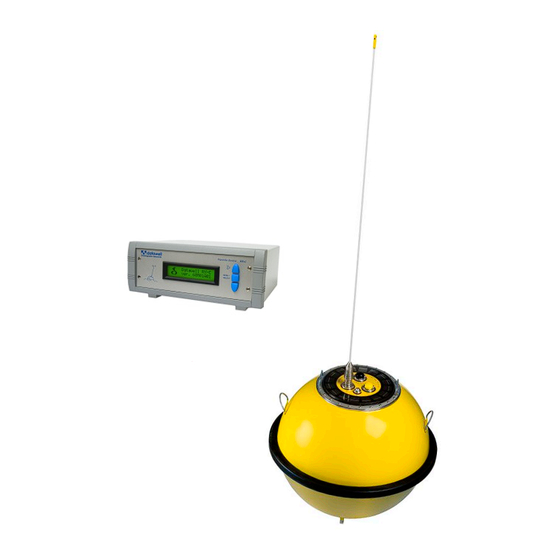
Summary of Contents for Datawell BV Waverider DWR-MkIII
- Page 1 Datawell Waverider Installation Guide DWR-MkIII, DWR-G, WR-SG RX-D, RX-C, Waves4 Service & Sales Voltastraat 3 1704 RP Heerhugowaard February ,2019 The Netherlands +31 72 534 5298 +31 72 572 6406 www.datawell.nl...
- Page 2 IMPORTANT • In case a transmitter is used within territorial waters a radio permit from the local authorities is obligatory. • The transmitting frequency band 28.0 – 29.7 is reserved for amateur radio operators and needs to be avoided.
-
Page 3: Table Of Contents
Contents 1 Introduction ....................5 2 Items required for wave measurement ............5 3 Dangers and warnings .................. 6 3.1 Dangers....................6 3.2 Warnings ....................6 4 Starting the buoy ................... 7 4.1 Buoy tester application ................7 5 Receiving antenna installation ..............7 6 RX-C4 and RX-D buoy receiver .............. -
Page 5: Introduction
1 Introduction Congratulations with your purchase of Datawell oceanographic equipment. You are building on over 40 years of oceanographic expertise. Over 4000 Datawell wave measurement buoys have been sold, providing high quality wave data of all oceans over the world. The oil industry, coastal engineers, governments, navies, harbour authorities, universities and scientific institutes all rely on our wave measuring equipment. -
Page 6: Dangers And Warnings
3 Dangers and warnings Datawell distinguishes dangers, threatening your life and warnings, threatening your equipment. Below you will find a summary of dangers and warnings related to the present product. 3.1 Dangers • Waverider buoys must be handled and serviced by qualified personnel only. •... -
Page 7: Starting The Buoy
4 Starting the buoy Before switching ON the buoy, unscrew the hatchcover from the hull, connect the plug at the end of the main hatchcover connector cable between the hull and the electronics unit as shown on the right and put the hatchcover back in place. -
Page 8: Software
7 Software Datawell has designed its own software as part of a complete wave measuring system, called Waves4 7.1 Waves4 Waves4 is configured to your specific setting using the Waves4 configurator. The Waves4 configurator acquires the data which is sent from the buoy. The configurator corresponds to the Waves4 software which is the presentation part of the software. -
Page 9: Extended
7.1.2 Extended The network consists of: Buoys Buoy 1 A deployed DWR4 buoy using the HF-link. Buoy 2 A deployed DWR4 buoy using the HF-link. Buoy 3 A deployed DWR4 buoy using the iBuoy communication option. Buoy 4 A deployed DWR4 buoy using the iBuoy communication option. Example of an extended network Receivers Receiver 1 An RX-C receiver using the serial connection. - Page 10 Display systems Computer D1 The computer displays the data of Buoy 1, Buoy 2, Buoy 3, Buoy 4. On this computer the following parts of the Waves4 suite are installed: • Waves4 Computer D2 The computer displays the data of Buoy 1, Buoy 2, Buoy 3, Buoy 4. This system is also used by the operator of the Waves4 suite.
-
Page 11: Mooring Preparation (Not For Dwr-G4)
8 Mooring preparation (not for DWR-G4) Even though the mooring is no sensor by itself, it is a crucial part of a wave measuring system. It solves the paradox of keeping the buoy on its location while at the same time allowing the buoy to follow the orbital wave motion. - Page 12 line loop by loop while the buoy drifts away from the ship and finally cut the rope that carries the sinker or push the sinker overboard. Continue to back up until the ship has gained enough distance to steer clear of the buoy and mooring line. Should anything go wrong, do not recover the buoy by pulling on the rubber cords.
-
Page 13: Buoy Recovery
10 Buoy Recovery IMPORTANT – During the recovery process the most dangerous item is the rubber cord(s). Stretching the cord(s) increases the level of danger and should be avoided whenever possible. There are several techniques for recovering a Waverider buoy. The most suitable method on any particular occasion will depend on the location, the weather, the sea state, the type/size of vessel being used, the availability of substitute equipment and, sometimes, operator experience/preference.

Need help?
Do you have a question about the Waverider DWR-MkIII and is the answer not in the manual?
Questions and answers